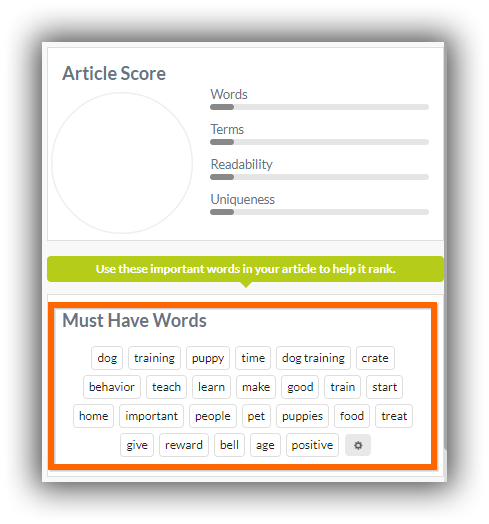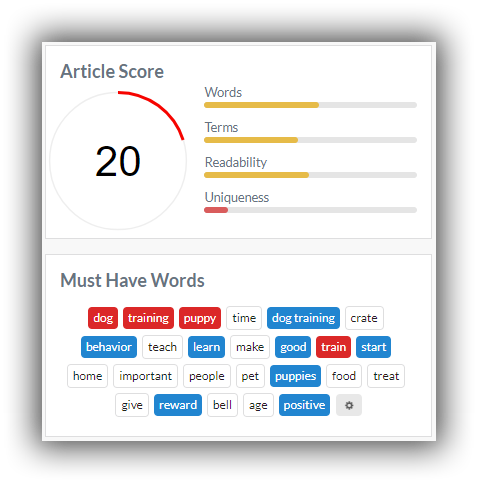If you want to rank for anything in Google you need content. The most important thing is to target one main keyword for each article you will write.
Main keywords are important. However, Google also considers the other words on your page!
Related keywords, ie semantically related words = latent semantic indexing or LSI for short.
Contents
What is LSI?
When you write about a topic, you will notice that certain words tend to occur together.
For example, if you are writing a review about iPhones you will most likely use the words Apple, iOS and siri in that review.
LSI is a algorithm that tries to capture the relationship between words.
An LSI Keyword will be any word that tends to occur with your main keyword in text.
LSI Keywords are not just:
- Synonyms: Although they can be, they are also words that appear frequently with your main keyword.
- Long tail keywords: Long tail keywords are 3+ longer word length search queries that you can find from tools like Google Keyword tool.
Example of LSI
If you read an article about Cat Stevens, here is a list of words that would most likely occur in the article.

Why is LSI important?
Google’s mission is to provide the best search experience for its users.
Here are the search results for “Cat Stevens” in Google.
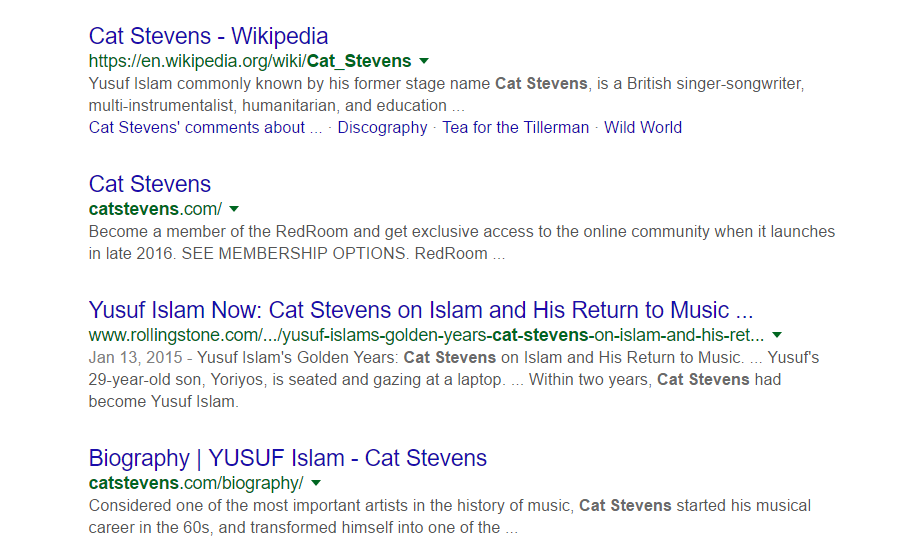
How does Google know I am searching for the artist Cat Stevens and not about a cat called Stevens?

By using LSI Google is able to match up your search query with documents that contain information about the artist and not about a cat.
It is able to do this because it knows from experience, that articles about Cat Stevens also have words like:
- music
- yusuf
- song
- album
- peace train
Incidentally these words form the basis of LSI Keyword optimization.
If you wanted to rank your articles for Cat Stevens, you would give Google a heads up that your article is relevant to the search query by strategically using these terms.
The more LSI keywords you use on a page, the more relevant Google is going to consider your article.
Keyword optimization?
You may have heard that you need your main keyword to appear a certain number of times in your article in order for it to rank well.
This is no longer the case. In fact, having your main keyword appear too many times is called ‘keyword stuffing’.
It turns out, that ‘keyword stuffing’ is associated with low quality articles and spam content. Both things that search engines are trying to get rid of.
By focusing on LSI keywords you will naturally avoid ‘keyword stuffing’ as you will instead use other related keywords.
How do you find LSI Keywords
Here are some free tools to find LSI keywords.
Google Search Suggest
When you type in the search box you get some suggestions for your query.

Technically these are search suggestions.
However, the words contained in them show what is related to the main keyword “Cat Stevens”.
If you scroll down to the end of the search listings, Google is kind enough to give you other suggestions.
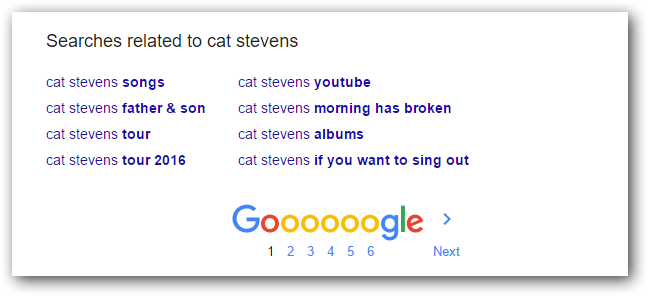
Google Correlate
Using data they have on search trends, you can use this tool to see what other queries are related to your main keyword.
The results are time sensitive, so it reflects what is “news” now.
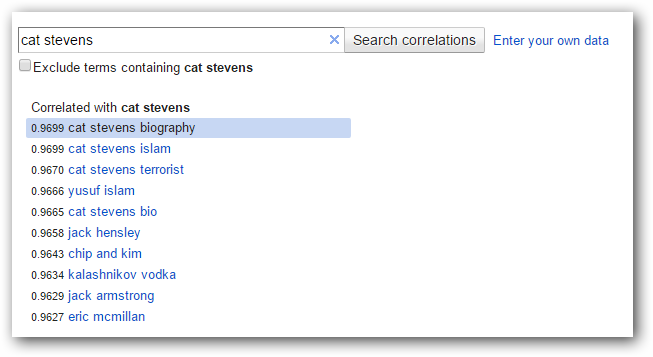
These aren’t all LSI keywords, but it does give you insights.
Google Keyword Tool
This free tool is the best one out there for giving you lots of awesome potential LSI keywords.
However you need to have a Google account to sign in to use the tool.
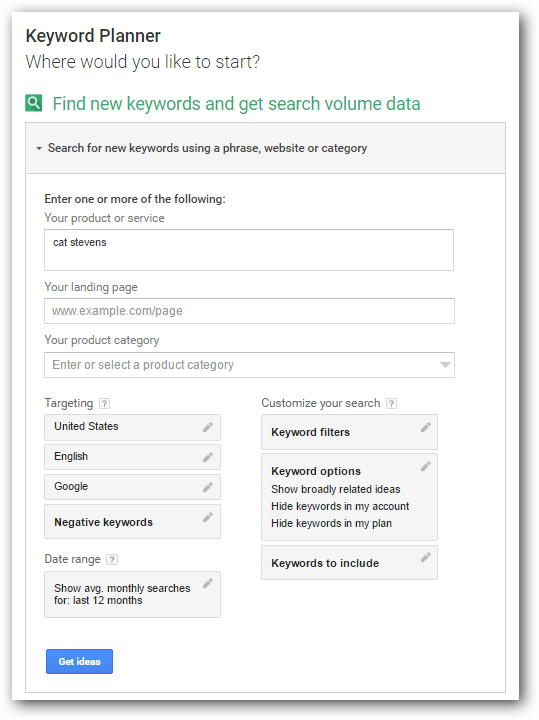
The tool is actually for Google Adwords but the keyword suggestions are an excellent source of LSI keyword ideas.
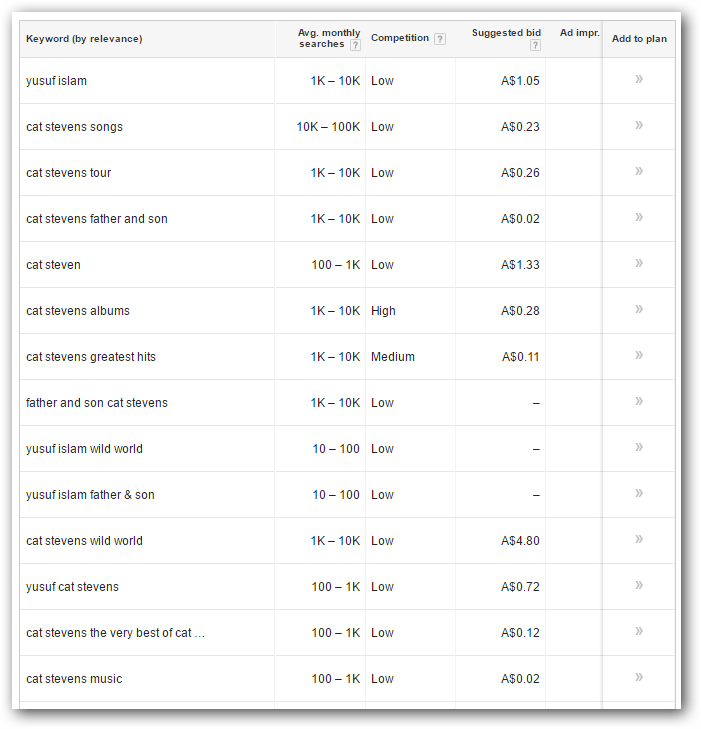
You even get estimates of search traffic for the different phrases.
You can download all these keywords to a CSV file that you can open in a spreadsheet.
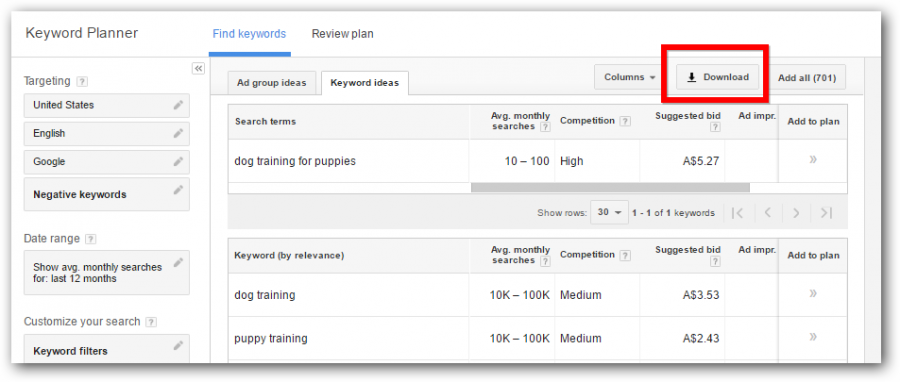
Choosing the right keywords
Once you have a list of LSI keywords, the next problem appears.
With such a big list, which words do you use?
In a perfect world you would use as many as you can (which is why longer posts tend to have higher ranking potential).
Reality dictates that:
- We use the most relevant keywords for our article. (not all keywords are usable)
- Prefer keywords that we think potential search users are typing to find our content.
An example…
Lets say we wanted to write an article about “Dog training for puppies”
Using the Google Keyword Tool we can download 700 keyword suggestions.
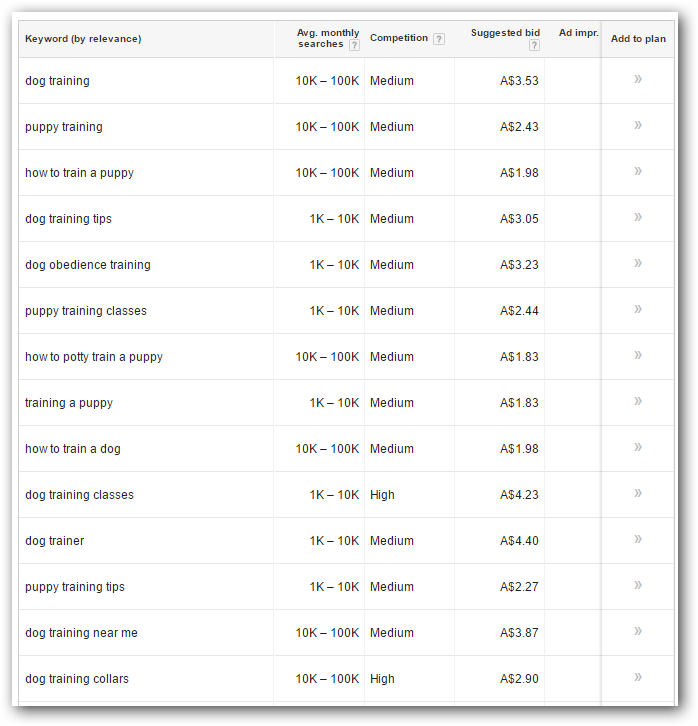
Step 1 – Rank
Export the keywords to a spreadsheet. Focus on the top 100 keywords (or more or less).
You can rank keywords by their potential search traffic, competition or even suggested bid.
There is no best method. You aren’t trying to rank for any term individually, you just want to cover as many terms in your article as you can.
Step 2 – Filter
Remove keywords that are obviously not going to be related to your article.
It could be that keywords are too specific eg:
- german shepherd training
- puppy training classes near me
Or the keywords themselves can be expanded into its own article. eg:
- housebreaking a puppy
- dog leash training
What you have left is rows of keywords that you can start peppering into your article.
Step 3 – Group
Keywords should be grouped into topics.
A good idea is to treat each topic grouping as a paragraph of text.
There is no “system for this”. It requires that you understand a little bit about your niche.
However you will notice going through your list of keywords, that many are about the same topic or idea.
You can lump these together.
Where to use LSI Keywords
You should use the LSI keywords anywhere in your article that you can.
There is no restriction since search engines will read all the text on your page.
However for your main keyword you should make sure that it appears in the:
- Title Tag
- Description (set it using a SEO plugin, or else most search engines will auto generate it)
- Permalink
Using Article Insights
The above method is the time tested method… IT is without a doubt time consuming and has the following problems.
- What exactly are the most important keywords?
- Filtering and grouping keywords is time consuming.
- If you don’t know your niche, grouping and filtering keywords would be very difficult to do.
- How do you remember what keywords you have used, and what you left out in your article
- Very difficult to use long keyword phrases in an article naturally.
- Overwhelming to do this for EVERY single article, imagine sifting through 700 rows of keywords before you WROTE a single word in your article.
There is a simpler solution that requires less brain power, leaving you to focus on what is important. Writing the article.
Here is a walk through of article insights.
Enter your article title
Click analyse and the tool will go online and analyse competing articles to find exactly what LSI keywords and keyword groupings you should use.

View the LSI keywords
Article Insights will do the keyword ranking and filtering for you.
It ranks the keywords from most relevant to less relevant.
The top 25 most important LSI keywords are shown to you.
That’s not all, Article Insights actually has a list of 200 LSI keywords.
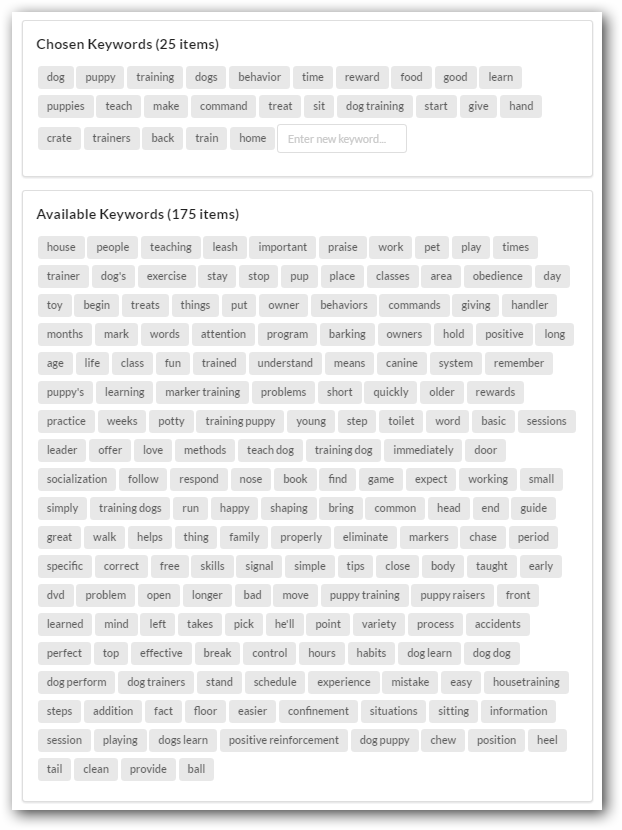
The list is filtered and ranked. The most important keywords appear at the top.
The Google Keyword Tool gives you search queries that contain LSI keywords. You need to spend time ranking, filtering and grouping those search queries before extracting out the LSI Keywords.
If a search is “how to train a puppy”, the LSI keywords is “train” “puppy”.
The other words are fillers like “to” and “a”.
Group the LSI keywords
Article Insights does what no other tool does, it will also group keywords into topics for you.

Understand LSI Keywords
If you are conducting research for your next article, some LSI keywords maybe new to you.
Article Insights can show you research for any LSI keyword so you know what is been written about it.
‘Crate’ turns up as a LSI keyword for “training puppies”. To see what experts mean by ‘crate’, Article Insights can show you a list of research.
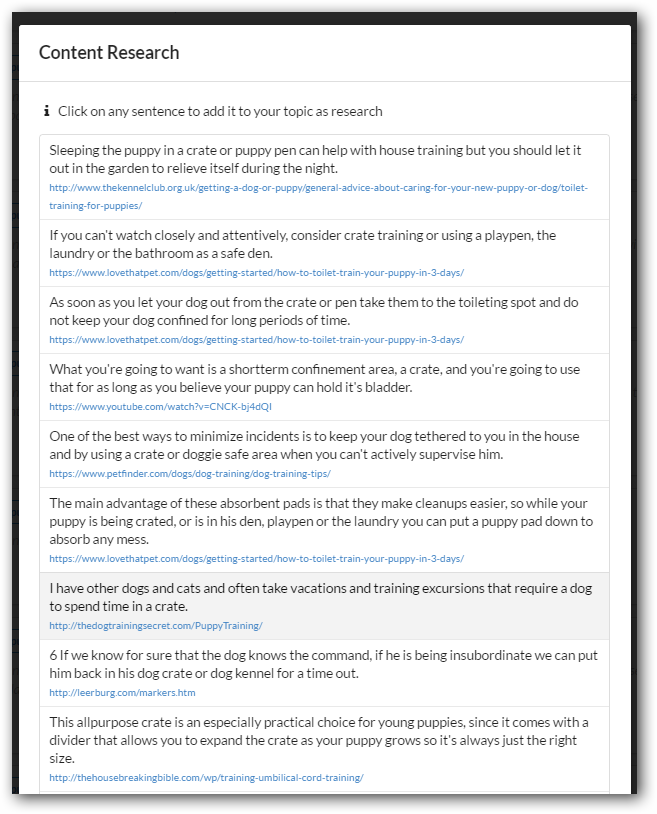
Using LSI Keywords
How do you keep track of what keywords have been used?
As you write, Article Insights does this for you.
Words that are used are colored using traffic light colors.
The colors turn green to yellow to red to show if you are overusing a particular keyword.
Red means you are overusing a keyword and that you should use a different word.
Your article performance
Article Insights scores your article out of 100 for its search ranking power.
Its scored based on:
- Words on the page (the more words the better)
- Usage of LSI keywords
- Readability
- Uniqueness (Article Insights compares what you write to see if its unique to other articles already ranking).
Article Insights is a simple paint by numbers system to research, write and optimize your articles using LSI keywords leaving you free to focus on writing.


